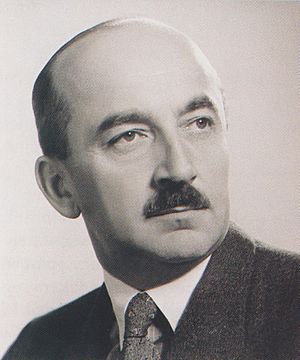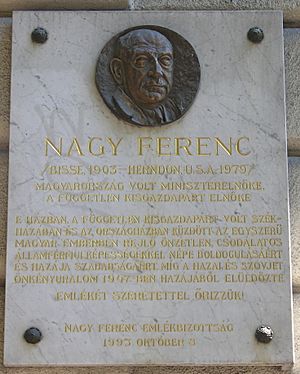Ferenc Nagy facts for kids
Quick facts for kids
Ferenc Nagy
|
|
|---|---|

Nagy in 1946
|
|
| 40th Prime Minister of Hungary 1st Prime Minister of the Second Hungarian Republic |
|
| In office 4 February 1946 – 31 May 1947 |
|
| President | Zoltán Tildy |
| Deputy | Mátyás Rákosi Árpád Szakasits |
| Preceded by | Zoltán Tildy |
| Succeeded by | Lajos Dinnyés |
| Speaker of the National Assembly of Hungary | |
| In office 29 November 1945 – 5 February 1946 |
|
| Preceded by | Béla Zsedényi |
| Succeeded by | Béla Varga |
| Member of the High National Council | |
| In office 7 December 1945 – 1 February 1946 |
|
| Preceded by | Béla Miklós Béla Zsedényi Mátyás Rákosi |
| Succeeded by | Zoltán Tildy as President of the Republic |
| Member of the National Assembly | |
| In office 15 June 1939 – 12 April 1944 |
|
| In office 2 April 1945 – 3 June 1947 |
|
| Personal details | |
| Born | 8 October 1903 Bisse, Austria-Hungary |
| Died | 12 June 1979 (aged 75) Herndon, Virginia, U.S. |
| Citizenship | Hungary United States (from 1947) |
| Nationality | Hungarian |
| Political party | Smallholders Party |
| Children | 5 |
Ferenc Nagy (born October 8, 1903 – died June 12, 1979) was an important Hungarian politician. He was a member of the Smallholders Party. He served as the Prime Minister of Hungary from 1946 until he was forced to resign in 1947. He was also the Speaker of the National Assembly of Hungary and part of the High National Council from 1945 to 1946.
Nagy was the second leader of Hungary to be chosen by the people in a fair election. He was also the last non-Communist prime minister until 1990. He was not related to the later Hungarian prime minister Imre Nagy.
Ferenc Nagy was a strong supporter of farmers and worked against the Nazis during World War II. As Prime Minister, he tried to make Hungary a true democracy. He led a government that included his party, the Communists, and the Social Democrats. However, he faced many challenges from the Soviet-backed Hungarian Communist Party. This party worked to weaken his government and destroy his party's power.
In June 1947, the Communist leader Mátyás Rákosi forced Nagy to resign. Nagy then went to live in the United States. There, he became a leader for Hungarians living outside their home country. He also taught about Eastern European politics. He tried to go back to Hungary during the Hungarian Revolution of 1956, but he could not. He lived the rest of his life in the U.S.
Contents
A Look at Ferenc Nagy's Life
Early Life and Political Beginnings
Ferenc Nagy was born into a family of farmers in a small town called Bisse. He started his political journey by writing articles. He taught himself and became involved in local farmer groups. He also helped start the Peasant Union. In October 1930, he helped create the Independent Smallholders' Party.
He became a member of the Hungarian Parliament in 1939. During World War II, Hungary was on the side of the Axis powers. Nagy worked against the war and the Nazis. When Germany took over Hungary in March 1944, the Gestapo (German secret police) arrested him. However, the Hungarian government helped him get released. After another change in government, Nagy went into hiding until the Red Army pushed the Nazis out of most of Hungary.
He helped set up a temporary government against the fascists. He was then elected to the Provisional National Assembly. Nagy quickly became the second most important person in the Smallholders' Party, after Zoltán Tildy.
Becoming Prime Minister
In the November 1945 elections, the Independent Smallholders' Party won a large number of votes and seats in Parliament. But the Soviet Union, which had a lot of power in Hungary, made them form a government with the Communists and Social Democrats. Nagy became the speaker of the new Parliament. Tildy became the Prime Minister. Both were part of the High National Council, which was like Hungary's temporary head of state.
In February 1946, Hungary became a republic. Tildy then became the President of Hungary, and Ferenc Nagy took his place as the new Prime Minister.
Ferenc Nagy as Prime Minister
Leading Hungary After the War
As Prime Minister, Ferenc Nagy tried to stop the Hungarian Communist Party from taking full control of the government. He believed in a democracy where people's representatives made decisions, not a dictatorship. Hungary was badly damaged by the war. His government began the work of rebuilding the country.
One big problem was hyperinflation, which meant money was losing its value very quickly. His government fixed this by replacing the old money (Hungarian pengő) with new money called the forint in August 1946. The United States helped with this by returning gold reserves that had been taken during the war. This gold was very important for making the new money stable.
His government also signed the Paris Peace Treaties of 1947. These treaties officially ended Hungary's part in World War II. Hungary agreed to give up any land it had gained during the war. It also agreed to pay money to the Soviet Union, Czechoslovakia, and Yugoslavia to help them rebuild. His government also made an agreement with Czechoslovakia to allow people to move between the two countries.
Challenges from the Communist Party
At the same time, the Communist Party started to use clever tactics against the Smallholders' Party. They wanted to take away the Smallholders' majority in Parliament. They began by demanding that the Smallholders remove their strongest anti-Communist members.
In March 1946, a "Left Bloc" was formed. This group included the Communists, Social Democrats, and the National Peasant Party. They opposed the Smallholders on almost every issue. Their goal was to create problems in the government to push their own plans. They first demanded that 20 "reactionaries" (people they didn't like) be removed from the Smallholders' group in Parliament. This made the Smallholders' majority smaller. The removed members then formed the Hungarian Freedom Party, which strongly spoke out against the Communists.
Many in his own party thought Nagy was too weak in dealing with these demands. But Nagy hoped to keep the Communists happy until a peace treaty was signed and their Soviet supporters left Hungary. He also hoped that by working with the Communists, Hungary could get better terms for the peace treaty from Moscow. However, the Communist Party's actions were mostly a way to gain more power for themselves.
The Coup of 1947
Starting in early 1947, the Communist Party, led by Mátyás Rákosi, attacked the Smallholders even more. They claimed that the Smallholders' leaders were part of a big plot. They used this as an excuse to arrest and remove over 50 Smallholder members of Parliament. This took away the Smallholders' majority that they had won in the election.
The Soviet Union, whose army was still in Hungary, helped the Communists. They provided fake evidence against Nagy. They also kidnapped Béla Kovács, a popular leader of the Smallholders' Party, and sent him to the Soviet Union.
On May 14, 1947, Nagy traveled to Switzerland. He likely hoped to tell Western countries about the worsening situation in Hungary. The Communists used this chance to get rid of him. On May 28, the Soviets showed false evidence that Nagy was involved in the supposed plot. Because the Communists had taken his son hostage in Budapest, Nagy agreed to resign on May 30. He officially resigned only after his son reached Switzerland on June 2.
Rákosi then chose Lajos Dinnyés, a Smallholder politician who was willing to work with the Communists, to replace Nagy on May 31. This gave the Communist Party real control over the Hungarian government.
Ferenc Nagy was given safety in the United States. He was the last non-Communist leader of Hungary until the fall of Communist rule and the return of free elections in 1989–90.
Life in Exile
Ferenc Nagy wrote about his life and political career in a book called The Struggle behind the Iron Curtain. It was published in 1948. The money from his book helped him buy a house in Herndon, Virginia, near Washington, D.C.
He stayed very active in politics even while in exile. He was a member of the Hungarian Committee in exile. He also attended the Bandung Conference in 1955 as an observer for the U.S. government. During the Hungarian Revolution of 1956, he tried to return to Hungary. However, authorities in Austria stopped him to keep their country neutral. He led the International Peasant Union from 1964 to 1970.
In the 1960s, he taught at different American universities. He received special honors from the University of Berkeley and Indiana University. He stopped being active in politics in 1970. But in 1977, he spoke out in favor of returning the Holy Crown of Hungary from the United States to Hungary. He died suddenly at his farm in Herndon in 1979. He had been planning to return to his home country.
See also
 In Spanish: Ferenc Nagy para niños
In Spanish: Ferenc Nagy para niños


